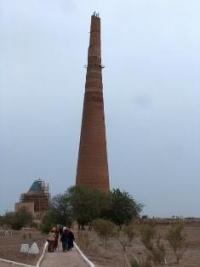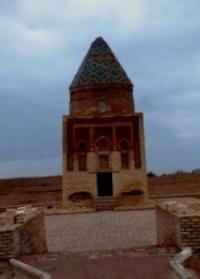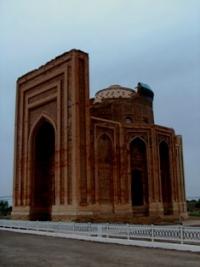Вы здесь
Kunya-Urgench ancient settlement.






Tours on main sights of Kunya-Urgench.
"Accordingly, Kunya-Urgench is considered to have retained its integrity better than most other sites in Central Asia as the attributes of the property are still present. The authenticity of the property has been preserved in the site layout and the use and the function of the site as a religious centre which is still continuing"
Tours on monuments of Kunya-Urgench.
The historical-cultural Reserve of Kunya-Urgench is the sacred for Muslims place, where the pilgrimage never stopped even during the times unfavourable for the believers. Today nobody prevents the pilgrims. People, who respect the tradition of the ancestors, openly come here.
The wide access to the monuments have also and tourists, those who earlier never dreamed to see the outstanding structures of the medieval governors of Khorezm. Undoubtedly, in the Golden age of Turkmen the past popularity of this ancient city will revive and it will take appropriate place on the maps and the guidebooks, new books and textbooks on history.
Kunya-Urgench is situated in north-western Turkmenistan, on the left bank of the Amu Daria River. Urgench was the capital of the Khorezm region, part of the Achaemenid Empire. The old town contains a series of monuments mainly from the XIth to XXVIth centuries, including a mosque, the gates of a caravanserai, fortresses, mausoleums and a 60-m high minaret. The monuments testify to outstanding achievements in architecture and craftsmanship whose influence reached Iran and Afghanistan, and later the architecture of the Mogul Empire of XVIth-century India.
Kunya-Urgench is located in the territory of Dashoguz velayat of Turkmenistan. It is situated in the north-western Turkmenistan, on the left bank of the Amu-Daria River. Urgench was the capital of the Khorezm region, which was part of the Achaemenid Empire.
The old town area contains series of monuments mainly from the XIth to XVIth centuries. This area has remained a vast deserted land with some remains of ancient fortified settlements, including a mosque, the gates of a caravanserai, fortresses, mausoleums and a 60-m high minaret.
On the sample of Kunya-Urgench monuments one can see all variety of methods and décor of Islamic architecture of Central Asia. There are constructions from adobe and burned bricks, plain unicameral dome constructions up-going to ancient chartak and buildings with complicated compositions, sometimes with а long history of development, repair and reconstruction.
These monuments also demonstrate the evolution of methods of treatment of inner surface of domes from cellular sails to stalactite those times called “muqarnas” and brought to the highest perfection by local masters.
The best monuments of this city are distinguished by high degree of decorativeness. They provide prominent examples of classical arabesques in monochrome terra-cotta and bright colorfulness of enamel. The monuments testify to outstanding achievements in architecture and craftsmanship whose influence reached Iran and Afghanistan, and later the architecture of the Mogul Empire of 16th-century India.
The Islamic sacred objects concentrated in this city are exceptionally popular places for pilgrims and serve attractive objects for the international tourism. The tradition of architecture expressed in the design and craftsmanship of Kunya-Urgench has been influential in the wider region to the south and southwest i.e. in Iran and Afghanistan, and later in the architecture of the Mogul Empire (India, XVIth century).
Kunya-Urgench provides an exceptional testimony to a cultural tradition (the Islamic culture of the Khorezm) and is unique in its state of preservation. The society that created this centre has disappeared; however we note that most of visitors are in fact pilgrims from the region.
The overall integrity of Kunya-Urgench as an archaeological site results from its historical condition. Having been abandoned for more than three centuries, and then used as a graveyard, the area has remained relatively intact.
Accordingly, Kunya-Urgench is considered to have retained its integrity better than most other sites in Central Asia as the attributes of the property are still present. The authenticity of the property has been preserved in the site layout and the use and the function of the site as a religious centre which is still continuing.
It is also preserved as a prominent pilgrimage centre of Islam. Although the individual monuments are in variable conditions, the principal monuments have retained a substantial amount of original material, representing a reasonable level of authenticity.
Other buildings have remained untouched or been more or less substantially reconstructed. The individual monuments have been subject to various degrees of repair, restoration and reconstruction. Seeing the condition before repair, it can be appreciated that in some cases the choice was a complete collapse or partial reconstruction.
While taking note of the several reconstructions of individual buildings, the principal monuments are still considered to have retained a reasonable level of authenticity. The property is protected by national legislation and also has local protection by the local municipality.
The State Historical and Cultural Park “Kunya-Urgench”, which contains the inscribed property within its limits, was created in 1985 (decree n° 10085). It is registered at the Vilayet (provincial) level (decree 440/16), approved by the State Cabinet of Ministers in 1992.
In addition, there are special bylaws, for example, for the protection of the area identified as the buffer zone. The legal protection of the property and its buffer zone is adequate. All elements of the property are included in the National Heritage List.
Listing in the National Heritage List implies that any proposed action to be taken inside or outside of boundaries of a National Heritage place or a World Heritage property that may have a significant impact on the heritage values is prohibited without the approval of the authorized government body.
A protection agreement which secures an inviolability of monuments and maintenance of conditions of economic activities and new constructions within boundaries of the buffer zone has been concluded between administration of the State Historical and Cultural Park “Kunya-Urgench” and local municipal authorities.
The property is currently in a good state of conservation with regular maintenance undertaken according to a maintenance schedule. There are two agencies with management authority: at the local level the administration of the State Historical and Cultural Park “Kunya-Urgench”, and at the central level the National Department for the Protection, Study and Restoration of the Historical and Cultural Monuments in Turkmenistan (DPM) in Ashgabat.
There is a general management system for the general policies of management and conservation of heritage sites. The system also provides general guidelines. More detailed plans are developed on the basis of these guidelines.
Such is the case also with the Kunya-Urgench, which includes a set of guidelines and annual work plans, controlling protection, research and monitoring. A management plan is currently in place for the property which takes into account a wide range of measures for planning and heritage legislation and policies of the Turkmenistan Government providing the policy framework for the conservation and management of the property which is scheduled to be updated every six years.
In regard to long term management issues, the property requires balanced management of conservation activities and passing both traditional and modern conservation techniques from one generation to the next.
Management of high pressure from tourism and urban growth also will be a long-term concern.
Main sights of Kunya-Urgench:
The mausoleum of the founder of Sufi sect of "kubr" Nadzhimetdin Kubra, the mausoleum of the Mongolian princess, Mamun's minaret, a minaret Kutlug-Timur, Kyrkmoll's mausoleum, ibn-Hadzhyba's madrasah, the mausoleum Arslan II, mausoleums Fakhr ad-Din Rasi, Azizan Al-Ramatani, Ahmed, Piryarveli's Siedi, Guligerdan, Horezimbag, Dashgala, Matkarim-Ishan, Sultan Ali, Tekesh-Horezmshakh reckon as the main sights of Konye-Urgench with a minaret of XIV in, Dashmedzhet and the fortress of Joint stock company-Kala as Torebeg-Hany.
Nadzimetdin Kubra mausoleum (XII - XIII century of century),
Mausoleum of the Mongolian princess Torebeg-Hanum (Turabekhkhanum, XII - XIV century of century),
Minaret Mamun (X - XI century of century),
Kutlug Timur minaret (XII - XIV century of century),
The mausoleum Kirk Mall (IInd century BC – the IIIrd century of our era),
Ibn Hadzkhiba's madrasah (XIV - XVI century of century),
Arskan II'S mausoleum (XIth century),
Mausoleum Fakhr ad-Din Rasi (XIIth century),
Mausoleum Azizan Al-Ramatani (XIII - XIV century of century),
Mausoleum Said Ahmed (XII - XIV century of century),
Piryarveli mausoleum (XIV - XVII century of century),
Mausoleum Guligerdan (XIIth century),
Mausoleum Horezimbag (XII - XVIII century of century),
Dashgal's mausoleum (XIV - XVI century of century),
The mausoleum Matkarim - Ishan (the XIX - XX century of century),
Mausoleum Sultan Ali (1580),
The mausoleum Tekesh - Horezmshakh (XIIth century) with a minaret of the XIVth century, Dashmedzhet (1903 - 1908),
Fortress of Joint stock company - Kala (Akgala) (I - III century in.).
Authority:
http://whc.unesco.org
Photos
Alexander Petrov.







